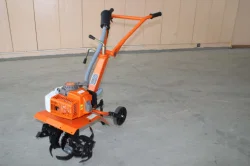Here are some features and considerations when choosing a garden cultivator
2024-03-22
A garden cultivator is a handheld or machine-powered gardening tool used for loosening soil, aerating the ground, removing weeds, and preparing the soil for planting. Cultivators come in various types, sizes, and designs to suit different gardening tasks and preferences. Here are some features and considerations when choosing a garden cultivator:
Handheld Garden Cultivator:
1. Design: Handheld cultivators typically feature a long handle with several prongs or tines at the end for digging into and turning the soil.
2. Material: Look for cultivators made from durable materials such as stainless steel or hardened steel for long-lasting performance.
3. Number of Tines: Consider the number of tines or prongs on the cultivator, as more tines provide better soil penetration and easier cultivation.
4. Tine Shape: Cultivator tines may be curved or angled for better soil penetration and weed removal.
5. Handle Grip: Choose a cultivator with a comfortable handle grip, such as rubber or foam, to reduce hand fatigue during extended use.
6. Weight: Consider the weight of the cultivator, as lighter models are easier to maneuver and less tiring to use.
7. Size: Choose a cultivator size that matches the scale of your gardening tasks, whether it's small-scale cultivation in raised beds or larger garden plots.
8. Multi-Purpose: Some handheld cultivators may have additional features, such as a hoe blade or serrated edge, for versatile use in different gardening tasks.
Powered Garden Cultivator:
1. Type: Powered garden cultivators come in various types, including electric, gas-powered, and battery-powered models.
2. Power Source: Consider the availability of power sources in your garden, such as electrical outlets or gasoline, to choose the appropriate type of powered cultivator.
3. Size and Power: Choose a cultivator size and power rating suitable for the size of your garden and the type of soil you'll be working with. Larger gardens or compacted soils may require more powerful cultivators.
4. Tilling Depth: Look for cultivators with adjustable tilling depth settings to accommodate different soil conditions and planting needs.
5. Ease of Use: Consider features such as easy-start mechanisms, ergonomic handles, and adjustable tine widths for comfortable and efficient operation.
6. Portability: If you have a large garden or need to transport the cultivator between locations, consider the weight and portability of the powered cultivator, including folding handles or detachable components for easy storage and transport.
7. Maintenance: Check the maintenance requirements of the powered cultivator, including blade sharpening, engine maintenance, and fuel or battery management.
Considerations When Choosing a Garden Cultivator:
1. Gardening Tasks: Determine the specific tasks you'll be performing with the cultivator, such as soil preparation, weed removal, or aerating, to choose the appropriate type and size of cultivator.
2. Soil Type: Consider the type and condition of your soil, such as clay, sandy, or loamy soil, to choose a cultivator that can effectively work with your soil type.
3. Garden Size: Choose a cultivator size and type that matches the scale of your gardening projects, whether it's small-scale cultivation in raised beds or larger garden plots.
4. Budget: Set a budget for the garden cultivator and compare prices, features, and quality among different brands and models to find the best value for your needs.
5. User Reviews: Read reviews and feedback from other gardeners to learn about their experiences with different cultivators and choose one that meets your expectations.
6. Warranty: Look for cultivators with a warranty or guarantee from the manufacturer to provide peace of mind and protection against defects or premature failure.
Overall, a garden cultivator is an essential tool for maintaining healthy and productive gardens, providing efficient soil cultivation, weed removal, and soil preparation for planting. By considering the features and considerations outlined above, you can choose the right garden cultivator to suit your gardening needs and preferences.



